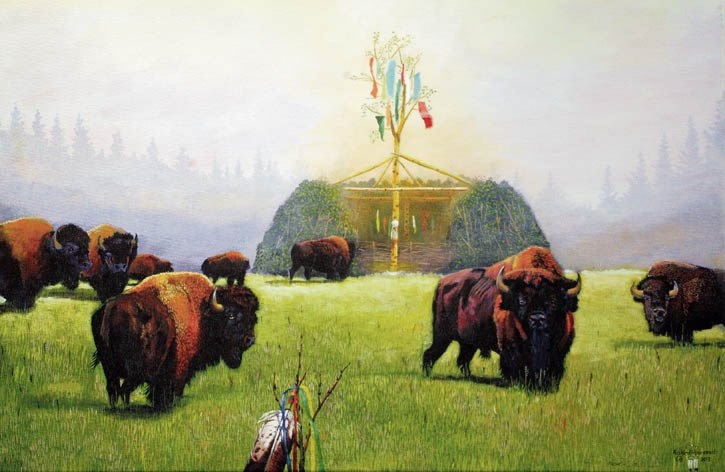Many years ago, Aboriginal people were deemed “savages” and white conceit dictated that everything they had, did or believed was archaic or simple.
In reality, all of that is so far from the truth – if that attitude wasn’t so tragic, it would be laughable.
Despite what many people of the time – including governments – would say, Aboriginal culture is complex, sophisticated and rich and Stoney Nakoda artist and elder Roland Rollinmud demonstrates this in his latest group of paintings currently on display at Elevation Place upstairs in the Three Sisters Gallery.
Each of the paintings and drawings Rollinmud shares in the exhibition relate to a different aspect of Aboriginal and Nakoda history and culture, spirituality and connection to place.
The Spirit of the Bow, for example, is more than a portrait of a Nakoda hunter with a bow, with notched arrow in his hands.
The man is John Hunter, Rollinmud’s grandfather, and the painting is as much about his relationship with his grandfather as it is about the complexity and sophistication of the bow and its design.
“We have never explained to the public how we create our ammo, particularly the bow,” Rollinmud said on Sunday (July 20).
Rollinmud’s grandfather made him a bow when he was still a boy. Hunter began by selecting a birch limb five feet long and four inches wide.
“He put it in the water and left it for a week and then he started to work on it,” Rollinmud said of the birch limb. “He didn’t just cut it down and begin work. That is not the way it is done,” Rollinmud said.
Once Hunter was finished shaping the birch limb, he put it back into the creek. In the meantime, Hunter took Rollinmud to collect Saskatoon berry stems, each about five feet long, to create arrows.
Using strips of mountain goat horns, he boiled to make them pliable, then fitted them along the bow with sinew.
“He stripped it so it was very flexible and once you put it on the bow it gave it a spring when you released, so it had more power,” he said.
They then collected Douglas fir sap and rubbed it into the bow. Once that was complete, Hunter took Rollinmud to a stand of poplar trees. The elder lashed the bow to three young poplars in order to bend the bow into its distinctive shape. They left it there for four days until it was ready for a rawhide bowstring.
From there, they continued to work on the Saskatoon berry stem arrows. The stems were shaped and fitted with stone arrowheads and duck feathers.
The whole process from start to finish took about a month, Rollinmud added, and every piece of it, along with the arrows, could be found in nature.
A painting of the Bow River at Dead Man’s Flats, meanwhile, is more than just a beautiful and peaceful landscape. It too comes with a backstory that connects to how Hunter and other Nakoda regularly relied on that location to gather herbs, hold vision quests and hunt; making it so much more than a place to camp, get gas and a meal.
Similarly, a work of a sundance lodge surrounded by bison is a beautiful and evocative piece that shares the story of the many elements of the Sundance.
The centre pole, a cottonwood tree known as the Tree of Life, was decorated with strips of coloured cloth, while a bison skull, known as powerful medicine, was placed at the base of the tree. A dense wall of willows encircles the Tree of Life like a nest.
“The nest around it is home for everybody and also the spirit of the air, which is the golden eagle, and all of the species of the air, so with that going inside, there is another layer where the dancers go and when they would start to sing they would come out with a whistle and it would sound like an eagle,” Rollinmud said.
“The bison represents the power of the home spirit, but I made it real bison so people would understand, but I made them hazy so they appeared as an apparition,” he said.
Each painting and pen-and-ink drawing is a way for Rollinmud to remind the public what Aboriginal people offered Canada in the past when it was fledgling nation and what they have to offer today.
“If we had fought, we would have been extinct and we never did,” Rollinmud said, referring to how Aboriginal people chose instead to share their lands with the government of Canada and predominantly white settlers.
“What grandpa told me was don’t fight the future, because the future is better change and living, but they are going to need us in the future, so we are working together,” he said.
Rollinmud’s exhibition at Three Sisters Gallery closes July 30.




